Key takeaways:
- Pro-life advocacy encompasses not only opposing abortion but also providing support and resources for mothers and families.
- Community support amplifies advocacy efforts, fostering trust and connection through shared experiences and resources.
- Effective advocacy strategies involve understanding the unique needs of the community and leveraging personal stories to inspire action.
- Encouraging dialogue and participation creates an inclusive atmosphere where individuals feel empowered to share their experiences and contribute to advocacy efforts.
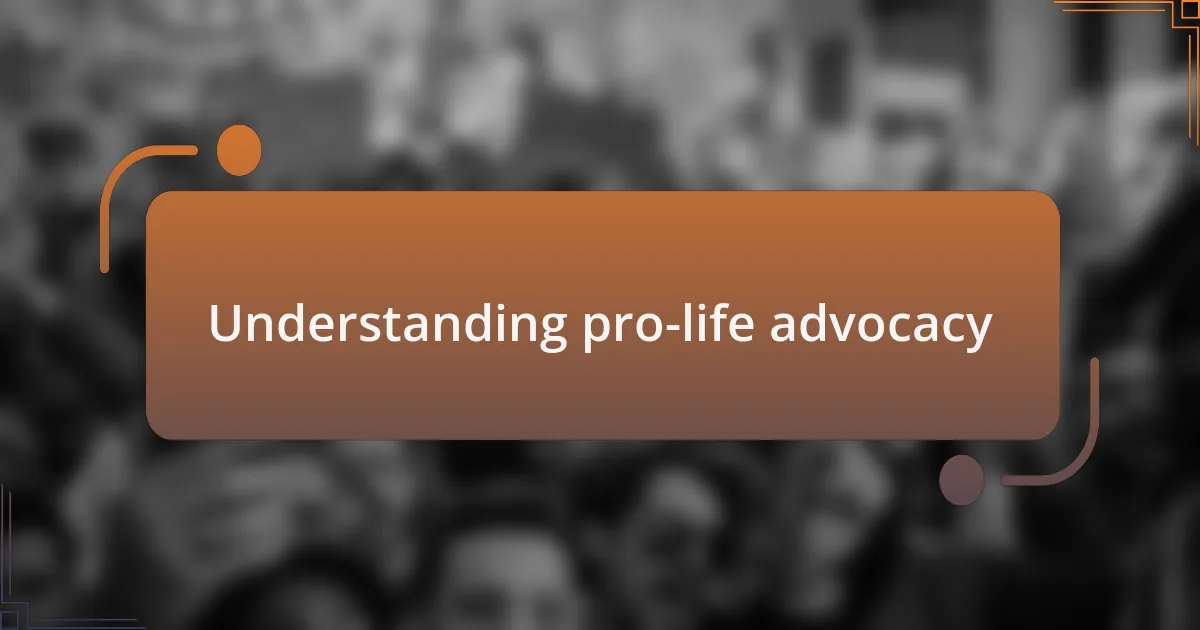
Understanding pro-life advocacy
Pro-life advocacy centers on the belief that every human life, from conception to natural death, holds intrinsic value. I distinctly recall my first experience at a rally; the passion in the crowd was palpable, and it made me think—what does it truly mean to stand up for life? I realized that advocating isn’t just about opposing abortion; it’s about fostering a culture that respects and cherishes all human beings.
As I delved deeper, I discovered that pro-life advocacy also encompasses support for mothers and families. I often reflect on conversations I had with women who felt backed into a corner, unsure and frightened. Listening to their stories ignited a desire in me to ensure that we provide more than just a stance; we need compassionate resources to help them navigate these complex choices.
Moreover, understanding this advocacy requires grasping the moral and ethical dimensions involved. I often find myself pondering how we can connect with those who may not share our views. How do we show empathy while firmly standing by our beliefs? It’s a delicate balance that challenges me to continuously learn and adapt in how I advocate.
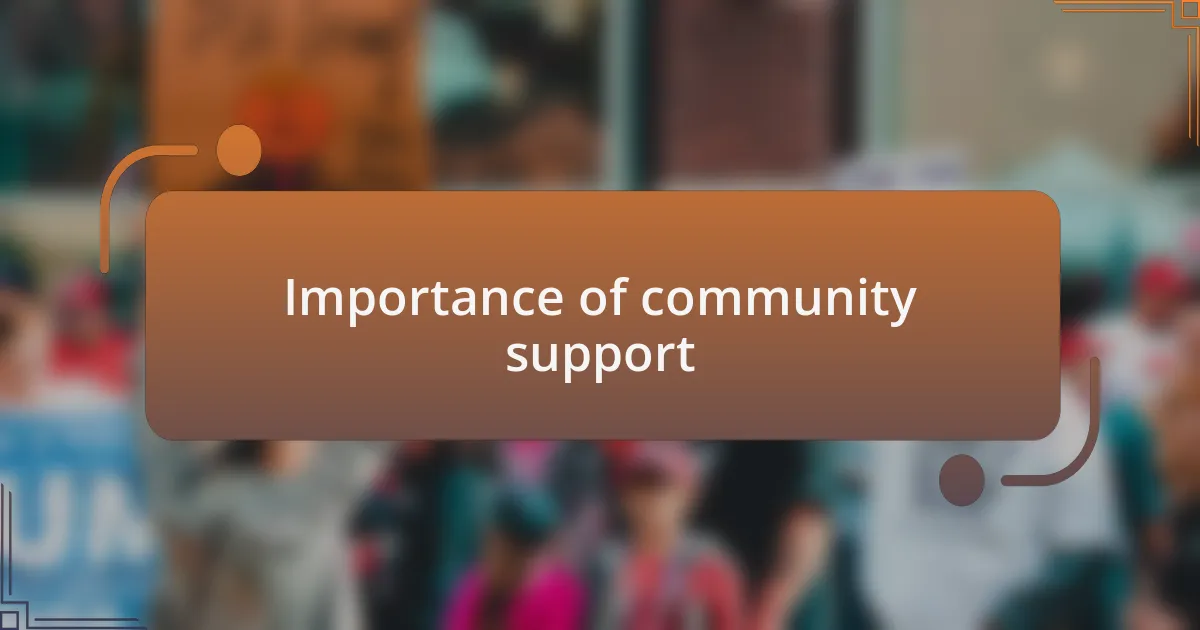
Importance of community support
Community support is the backbone of effective pro-life advocacy. I remember attending a local meeting where community members rallied to share resources for pregnant women in need. It struck me how vital these connections are; when we unite, our voices become amplified, and our impact deepens.
In my journey, I’ve seen firsthand how community networks can transform lives. A friend of mine, who found herself unexpectedly pregnant, confided in me about her fears. It was the support from our local church group that provided her with a positive outlook and practical assistance, reminding me that together, we can nurture lives and foster hope.
Reflecting on these experiences, I often wonder—what could we achieve if every member of our community felt empowered to contribute? Just imagine the ripple effect that comes when individuals stand together! When support is abundant, we create an atmosphere where everyone feels valued and heard, and that’s crucial for advancing pro-life messages effectively.
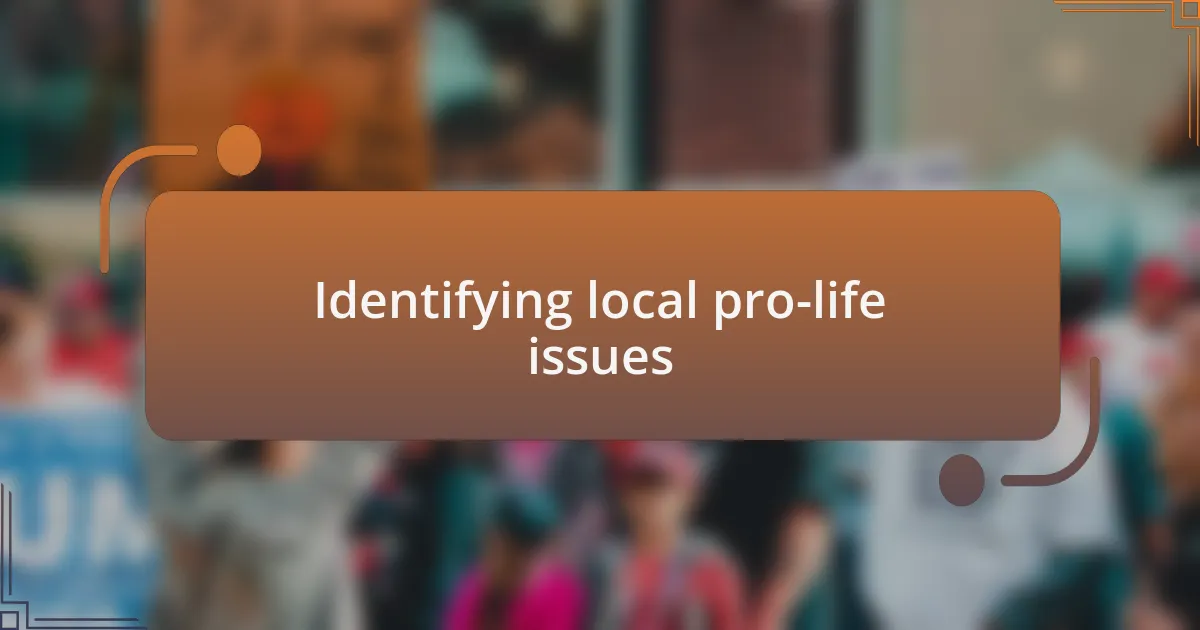
Identifying local pro-life issues
Recognizing the unique pro-life issues within my community started with a simple observation: local resources often went underutilized. I remember walking through our neighborhood and stumbling upon a crisis pregnancy center that barely advertised its services. This made me question, how many women might be unaware of such vital support? It sparked my determination to not only spread the word but to also engage with the center and learn more about their specific challenges.
As I delved deeper, it became clear that education played a crucial role. During a town hall meeting, I asked fellow community members about their perceptions of pro-life resources. It amazed me to discover varied opinions shaped by misinformation. Recognizing that many residents are misinformed about available support truly ignited a passion in me to advocate for transparency and communication. It left me pondering: what if we organized educational workshops to clarify these misconceptions and encourage open dialogues?
Watching a local family thrive thanks to the support of charities made the need for targeted advocacy crystal clear. They shared their struggle with financial instability when expecting, underscoring the pressing need for affordable healthcare options and childcare resources in our area. This experience reinforced my belief that addressing these local pro-life issues goes beyond policy; it’s about understanding the personal stories and providing tangible solutions that uplift our community.
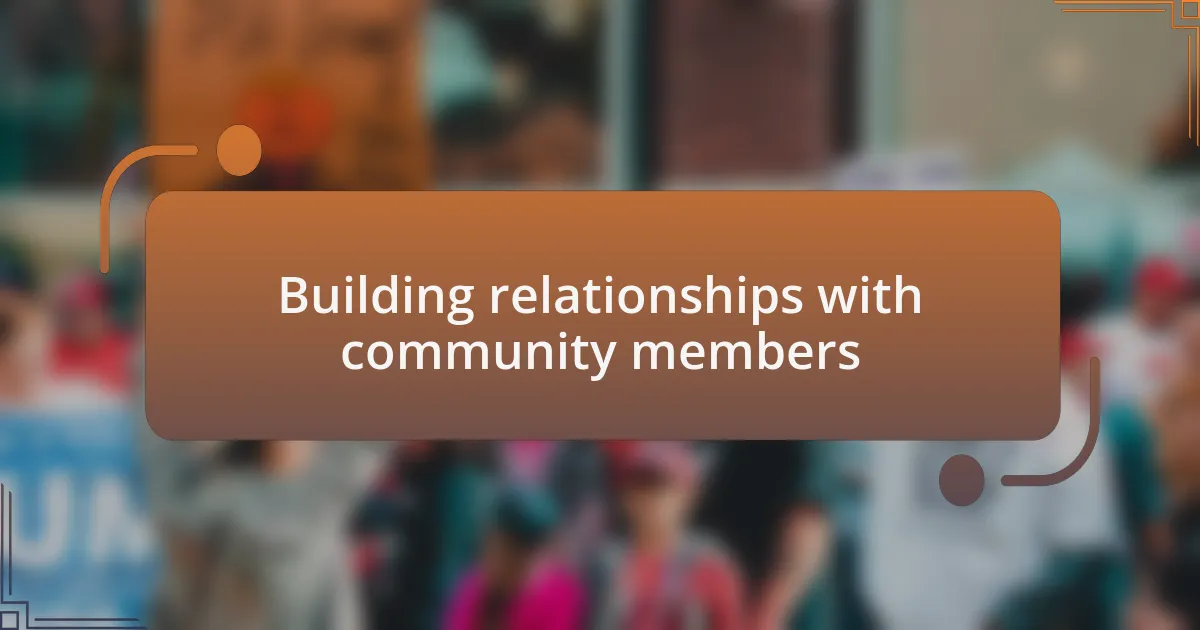
Building relationships with community members
Building relationships with community members has been a transformative experience for me. One day, while volunteering at a local event, I struck up a conversation with a mother who felt isolated in her journey as a new parent. Listening to her recount her struggles made me realize how essential it is to create spaces where people feel safe and supported. How many others out there share similar feelings of loneliness and need connection?
Through these interactions, I’ve learned the power of being genuinely present. I recall joining a small community gathering where I simply listened to others share their stories. By providing a platform for voices to be heard, I noticed how quickly trust and camaraderie developed. It reminded me that advocating for our community is often about the relationships we nurture, not just the issues at hand. These bonds lay the foundation for collective action and support.
Sometimes, it’s the small gestures that leave lasting impacts. One evening, I delivered homemade meals to new families in the neighborhood, hoping to ease their burdens. The gratitude I received was overwhelming, and it wasn’t just about the food; it was the connection formed over shared struggles and joys. How simple acts can foster deeper relationships and create a sense of belonging! This experience taught me that advocacy starts at the grassroots level, where compassion and understanding can propel real change.
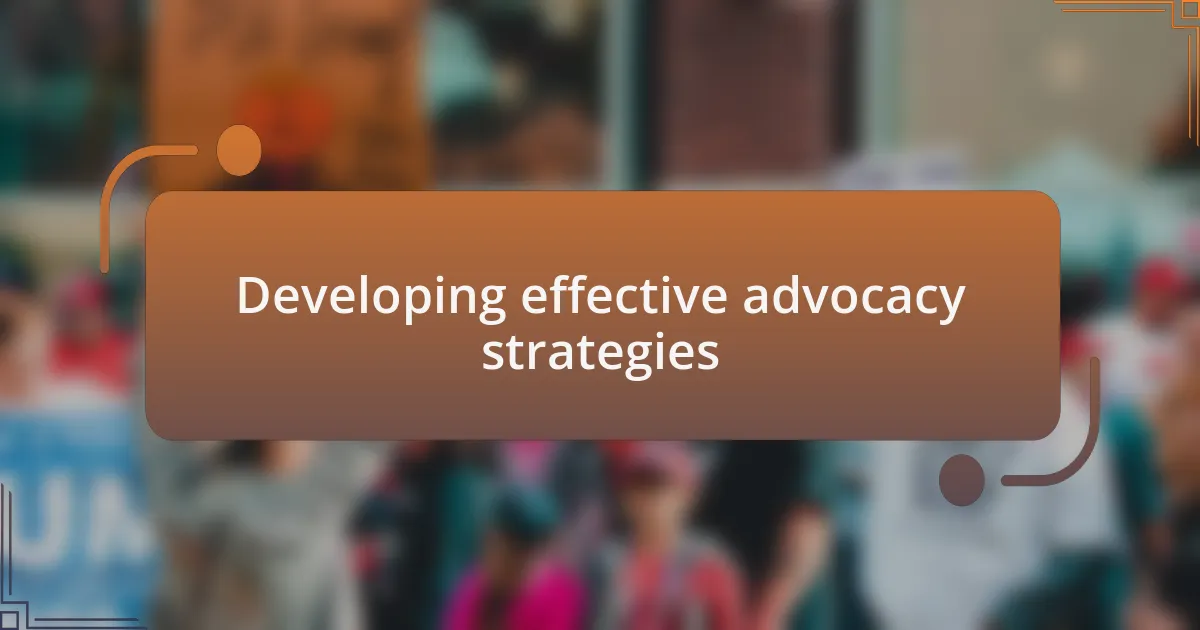
Developing effective advocacy strategies
When developing effective advocacy strategies, I’ve found that tailoring my approach to the unique needs of the community is crucial. For instance, during a recent workshop, I observed how community members light up when the discussions center on their values and concerns. This realization pushed me to ask questions that resonate deeply with them, sparking an open dialogue that not only informed my strategies but also encouraged active participation. Isn’t it fascinating how understanding one’s audience can shape our advocacy efforts?
Additionally, I once organized a local forum to address specific issues faced by families in our area. I invited experts who could share insights directly related to our community’s needs, but what truly enriched the experience was the opportunity for family members to voice their stories. I remember one father speaking passionately about the lack of resources for new parents, and it struck a chord with everyone present. By weaving their narratives into our advocacy framework, we created a compelling and relatable case that drew more support than I had imagined.
Moreover, leveraging digital tools has proven to amplify the reach of our advocacy. I initiated a social media campaign that featured short video testimonials from community members sharing their experiences. The response was incredible! People began to engage, share their struggles, and express their hopes, showing just how powerful storytelling can be in mobilizing others. How can we harness the digital space more effectively to tell our story? By doing so, I’ve witnessed firsthand how a well-crafted narrative can turn empathy into action, sparking genuine demand for change.
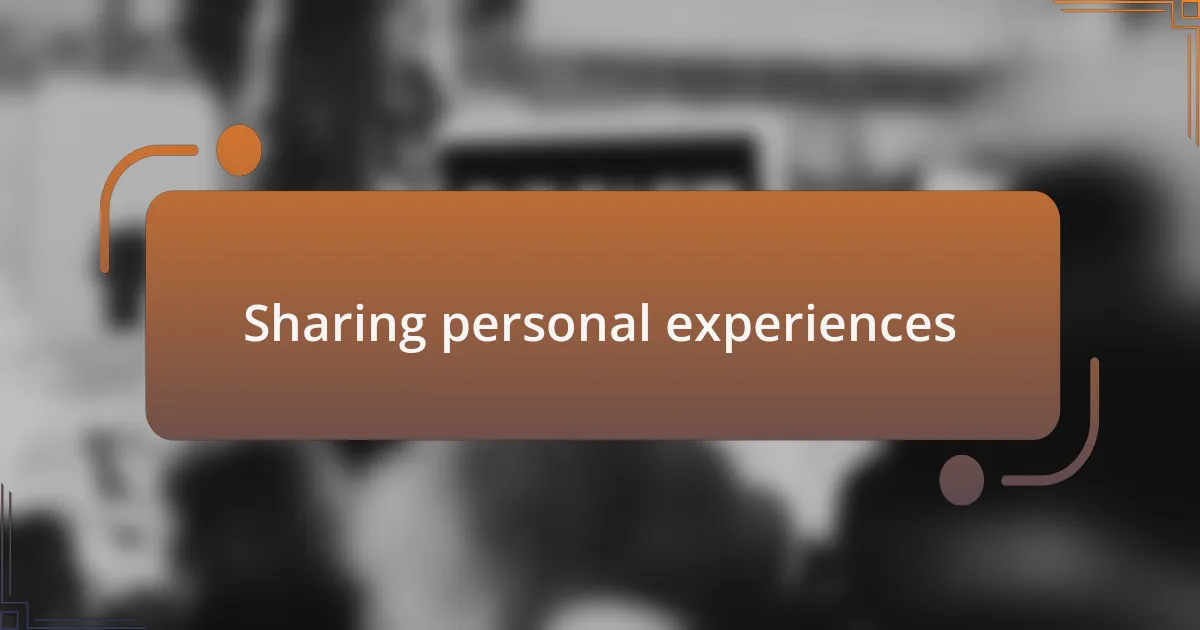
Sharing personal experiences
Sharing personal experiences can serve as a powerful tool in advocacy. I recall a moment when I spoke at a community event about my own struggles with navigating healthcare options. As I shared my journey, a woman approached me, visibly moved, and said my story gave her the courage to ask questions she had been holding back for years. It was a simple reminder: our individual narratives can resonate deeply and encourage others to find their voice.
One time, during a small gathering, I listened intently as a young mother shared her experience with unexpected pregnancy. Her honesty about the fear and uncertainty she felt was palpable. It reminded me of how important it is to create spaces where people can speak freely about their challenges. When I shared my own advocacy journey, emphasizing hope and support, it sparked an exchange that transformed the atmosphere from one of apprehension to solidarity. Have you ever felt the weight of another’s story change your perspective?
As I reflect on these experiences, I realize that sharing our stories isn’t just about transmitting information; it’s about building a community. It’s in these vulnerable moments where connections are forged. Making the decision to be transparent about our journeys can foster a sense of unity and strength that propels our advocacy efforts forward. How can we continue to encourage openness among ourselves and others? We must keep creating opportunities for dialogue, celebrating every story as a stepping stone towards greater understanding and action.
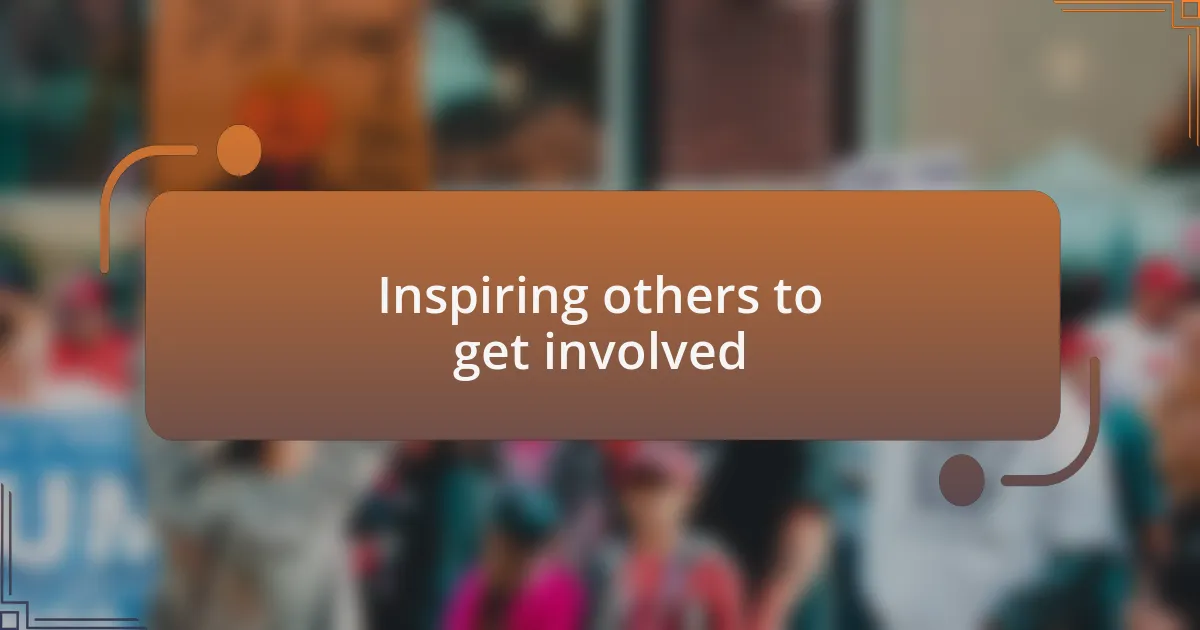
Inspiring others to get involved
In my experience, inviting others to join advocacy efforts often begins with small, relatable actions. When I organized a neighborhood meeting to discuss local pro-life initiatives, I shared stories from my own life, encouraging everyone else to do the same. The way people’s eyes lit up as they realized their voices were valued made me appreciate how deeply personal connections can spur collective action.
One memory stands out: I asked a close friend to share her thoughts on the role of community in supporting life. Initially hesitant, she opened up about her family’s journey with adoption. Her passion ignited the room, and soon, others found the confidence to express their ideas and concerns. Isn’t it fascinating how one person’s courage can create a ripple effect? I witnessed firsthand how empowered individuals can motivate their peers to make a difference.
Recognizing the barriers some face in speaking out, I often remind them that every contribution counts, no matter how small. During a volunteer event, a newcomer shyly suggested we write letters to local representatives. Watching a group rally around her idea was exhilarating; it demonstrated how inclusive dialogue leads to collective inspiration. I believe we each hold a spark waiting to ignite a larger flame. How might you inspire someone to take that first step?